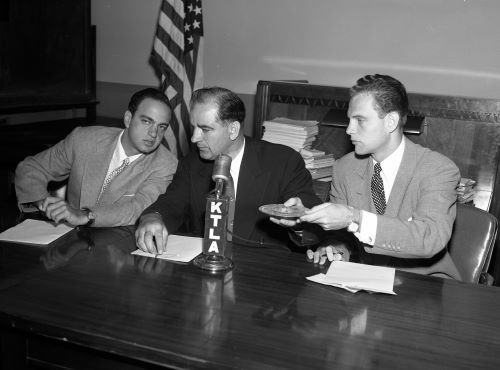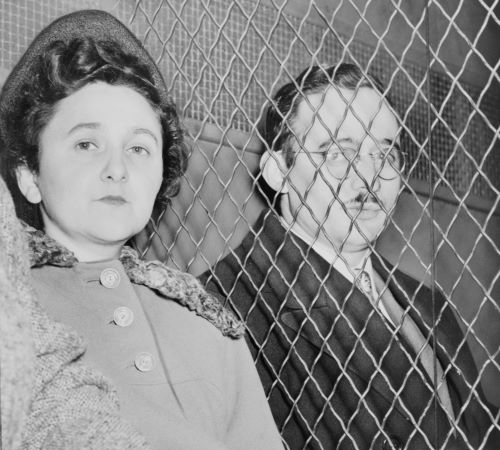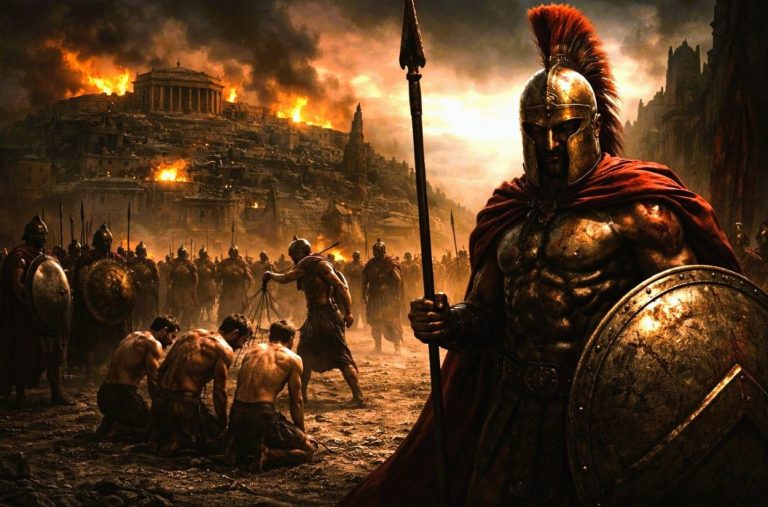

To understand Roy Cohn is not to understand a villain. It is to understand a system that allowed performance to masquerade as procedure, fear to displace reason, and legality to become theater.

By Matthew A. McIntosh
Public Historian
Brewminate
Introduction: A Man for the Inquisition
Few names in the annals of American legal and political history provoke the same visceral blend of fascination and revulsion as Roy Cohn. Architect of prosecutions, confidant of power, master of intimidation, Cohn came to prominence during one of the most volatile chapters in twentieth-century America: the Red Scare. In the crucible of anti-communist paranoia, where suspicion was valorized and denial was guilt, Cohn was both artisan and emissary of the witch hunt.
Although Joseph McCarthy remains the public face of the Second Red Scare, Cohn’s influence behind the scenes was no less decisive. As chief counsel to McCarthy’s Senate Permanent Subcommittee on Investigations, Cohn infused legal process with ideological warfare. He brought a ruthless prosecutorial energy to the stage-managed spectacle of congressional hearings, weaponizing insinuation and procedural dominance against a backdrop of Cold War dread.
Cohn did not merely serve power. He helped shape its methods. His role in the trial of Julius and Ethel Rosenberg, his tenure with McCarthy, and his later career as a lawyer to the rich and untouchable all form part of a single continuum, a life spent in the service of public condemnation and private influence. To study Roy Cohn during the Red Scare is to understand the mechanics of fear in an era that elevated the theater of accusation over the dignity of evidence.
The Rosenberg Trial: Laying the Foundation for a Career in Fire

Roy Cohn’s ascent began in the federal courtroom. At only twenty-three, he served as an assistant U.S. attorney in the prosecution of Julius and Ethel Rosenberg, accused of passing atomic secrets to the Soviet Union. Although the trial remains one of the most controversial in American legal history, at the time it offered Cohn a national stage on which to demonstrate his talents for cross-examination, political timing, and dramatic flourish.1
Cohn later claimed responsibility for persuading the judge to sentence both Rosenbergs to death, a boast as chilling as it was revealing. It was not merely conviction that interested him, but spectacle. The Rosenberg case, tried during the early heat of the Korean War, provided the public with a clear morality tale: the enemy within, the sanctity of national security, and the righteous force of American law.
Legal scholars have long questioned the fairness of the Rosenberg trial, particularly the paucity of direct evidence implicating Ethel. But in the courtroom, Cohn was less interested in procedural purity than in ideological vindication. The trial gave him not only notoriety but a template: frame the accused as a threat to national survival, bypass ambiguity, and pursue the verdict as an end in itself.2
McCarthy’s Counsel: Performance Law and the Senate Stage

In 1953, Senator Joseph McCarthy selected Roy Cohn as chief counsel to his Permanent Subcommittee on Investigations. It was a union not of equals but of temperaments. McCarthy provided the populist thunder. Cohn provided the legal lightning. Their collaboration coincided with the most aggressive phase of the Red Scare, a period during which allegations of communist infiltration in government and culture reached fever pitch.
Cohn’s legal approach was adversarial to the core. He understood that congressional hearings, unlike courtrooms, were unburdened by rules of evidence or the presumption of innocence. The hearings were part political ritual, part public theater. Cohn operated within them like a conductor, orchestrating suspicion, guiding witnesses into contradiction, and wielding subpoena power with a precision that blurred law and vengeance.3
The infamous investigations into Voice of America, the State Department, and ultimately the Army-McCarthy hearings all bore Cohn’s fingerprints. His feud with the Army over the special treatment of G. David Schine, a friend and aide, eventually exposed the recklessness of McCarthy’s crusade and contributed to its collapse.
Yet even in failure, Cohn’s tactics left a legacy. He demonstrated how legal authority could be transformed into a cultural weapon, how reputation could be dismantled without conviction, and how fear could be sustained without proof.
The Architecture of Fear: Cohn’s Legal Aesthetic

To understand Roy Cohn’s significance during the Red Scare, one must look beyond individual cases to his deeper ideological method. Cohn believed in weaponized legality. He did not see law as a forum for impartial deliberation but as a lever of power. He was a jurist of the spectacle, whose technique involved destabilizing the subjectivity of the accused while reinforcing the moral certainty of the state.
This approach dovetailed perfectly with the psychology of the era. Cold War America was defined by a paradox: a superpower that projected global dominance while internally consumed by vulnerability. Communism became the cipher for all domestic anxiety—economic, racial, sexual, and cultural. Cohn’s genius lay in tapping that anxiety and giving it legal expression.
In his hands, questioning became insinuation, and refusal to answer was tantamount to confession. The logic of guilt reversed itself: it was the demand for proof that now seemed subversive.
Though ostensibly opposed to totalitarianism, Cohn’s methods mirrored many of its features: loyalty oaths, guilt by association, surveillance of thought. The machinery he helped build in the 1950s would outlive the decade, resurfacing in later domestic intelligence programs and political smear campaigns.
After McCarthy: The Shadow Elite and the New Cold War
After McCarthy’s censure in 1954 and subsequent decline, Cohn resigned from the Senate and returned to private practice. But he did not retreat from public influence. Instead, he reinvented himself as a lawyer for the rich, the powerful, and the scandal-plagued. Among his clients were real estate magnates, Mafia figures, and, most notoriously, a young Donald Trump.4
Cohn remained publicly committed to anti-communism, but the target had shifted. By the 1960s and 1970s, the focus was no longer just on state infiltration, but on student radicals, civil rights activists, and countercultural dissenters. The aesthetic remained the same: disdain for liberalism, admiration for authoritarian resolve, and the cynical manipulation of law to punish perceived enemies.
This phase of Cohn’s life is often viewed as distinct from his Red Scare years, but in truth it was a continuation. He applied the same tools (threats, press manipulation, legal attrition) to new contexts. He blurred the boundary between state loyalty and personal vendetta, between national security and personal gain.
Even as the ideological temperature of the Cold War cooled, Cohn kept the embers alive, particularly through his ties to conservative networks that would later dominate the Reagan years. His style was never about ideology alone. It was about control.
Conclusion: The Lie That Feels Like Truth
Roy Cohn was never the most powerful man in America. But he was one of its most consequential. His role in the Red Scare was not that of an aberration, but of a symptom. He gave form to a certain kind of national self-deception: the belief that justice and suspicion are compatible, that security requires submission, and that enemies can be found if one only looks hard enough.
Cohn’s legacy is not confined to history. His methods, relentless attacks on institutions, the elevation of loyalty over law, the transformation of public hearings into public trials—remain visible in the political culture he helped to shape.
To understand Roy Cohn is not to understand a villain. It is to understand a system that allowed performance to masquerade as procedure, fear to displace reason, and legality to become theater. In the end, his genius was not in what he proved, but in what he made believable.
Appendix
Footnotes
- Walter Schneir and Miriam Schneir, Invitation to an Inquest: A New Look at the Rosenberg-Sobell Case (Garden City, NY: Doubleday, 1965), 110–112.
- Ellen Schrecker, Many Are the Crimes: McCarthyism in America (Princeton: Princeton University Press, 1998), 101–105.
- David M. Oshinsky, A Conspiracy So Immense: The World of Joe McCarthy (New York: Free Press, 1983), 254–267.
- Wayne Barrett, Trump: The Deals and the Downfall (New York: HarperCollins, 1992), 154–158.
Bibliography
- Barrett, Wayne. Trump: The Deals and the Downfall. New York: HarperCollins, 1992.
- Oshinsky, David M. A Conspiracy So Immense: The World of Joe McCarthy. New York: Free Press, 1983.
- Schneir, Walter, and Miriam Schneir. Invitation to an Inquest: A New Look at the Rosenberg-Sobell Case. Garden City, NY: Doubleday, 1965.
- Schrecker, Ellen. Many Are the Crimes: McCarthyism in America. Princeton: Princeton University Press, 1998.
Originally published by Brewminate, 07.23.2025, under the terms of a Creative Commons Attribution-NonCommercial-NoDerivatives 4.0 International license.


